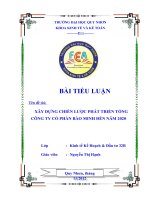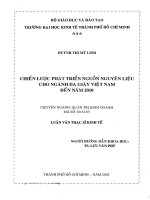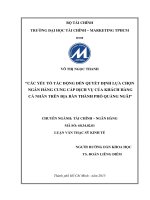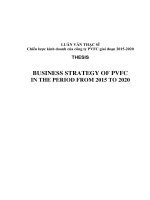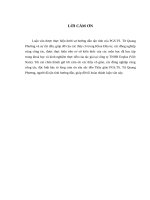LUẬN văn THẠC sĩ CHIẾN lược PHÁT TRIỂN tại CÔNG TY CIENCO 507
Bạn đang xem bản rút gọn của tài liệu. Xem và tải ngay bản đầy đủ của tài liệu tại đây (638.87 KB, 80 trang )
LUẬN VĂN THẠC SĨ
CHIẾN LƯỢC PHÁT TRIỂN TẠI CÔNG TY
CIENCO 507
BUSINESS STRATEGY DEVELOPMENT AT THE CIVIL
ENGINEERING CONSTRUCTION COMPANY LIMITED 507
ACKNOWLEDGEMENTS
First of all, we own our imbedded would like to thanks to the Center of Training
Technology and Employment System, Ha Noi National University, who has organized
successfully for their successful organization of the International Training Course of
Master of Business Administration for class GaMBA01.N06. The course has provided
us with the essential knowledge in the field of business management. In particular, We
have learnt numerous tools for strategic analysis and development for the studied
Company, and the current global modern trends of business strategy development.
Such tools and knowledge are useful to our work.
Next, we are sincerely grateful gratitude to the lecturers, who have earnestly
provided us with interesting lectures throughout the course for their supervision and
guidance. We are especially thankful would like to express our sincerely thank to Ms.
Kim Thanh, who has enthusiastically guided us tremendous enthusiasm in guiding us
in our the completion of this capstone project. Our paper would not be a success could
not be success without the support from the Transport Engineering Corporation 5 and
One-member Limited Liability Engineering Company 507 Civil Engineering
Construction Company Limited 507, who which have provided us with the requested
necessary data and information, and arranged the interviews with their key corporate
leaders.
Last but the not the least, we are thankful to would like to express our deepest
appreciation to the Monitor and Management Team of the Intake for their continuous
support and encouragement in our completion of this assignment capstone project.
TABLE OF CONTENTS
i
EXECUTIVE SUMMARY...............................................................................…..1
1
Rationale........................................................................................................1
2
Objective........................................................................................................1
3
Methodology..................................................................................................1
3.1
Data Collection..............................................................................................1
3.2
Data Analysis.................................................................................................2
4
5
6
1.1
1.1.1
Value of the Capstone project.......................................................................2
Limitations.....................................................................................................2
Structure of the Capstone project................................................................2
Business Strategy – Definition, Role and Key features...............................4
Definition........................................................................................................4
1.1.2
The Role of Business Strategy........................................................................5
1.1.3
Key Features...................................................................................................6
1.2
1.2.1
Types of Business Strategies.........................................................................7
By Level of Business Management...............................................................7
1.2.2
By Content of the Strategies.........................................................................7
1.2.3
By Characteristics of each Strategy.............................................................7
1.2.4
By Strategic Process......................................................................................7
1.3
1.3.1
Business Strategy Development Process......................................................8
Corporate Mission and Key Objectives...........................................................8
1.3.2
Business Environment Analysis......................................................................9
1.3.2.1 External Environment Analysis.......................................................................9
1.3.2.2 Internal Environment Analysis......................................................................10
1.3.3
Crafting Business Strategies Strategy analysis and selecting strategies........12
1.3.3.1 Matrix of External Factors External Factor Evaluation Matrix (EFE matrix)
12
Resouce: Strategic Management-Concepts and cases.................................................13
1.3.3.2 Matrix of Internal Factors (IFE ) Internal Factor Evaluation Matrix (IFE
matrix) 13
Resouce: Strategic Management-Concepts and cases.................................................14
1.3.3.3 SWOT Matrix................................................................................................14
Resouce: Strategic Management-Concepts and cases.................................................15
1.3.3.4 Competitiveness Picture Matrix (CPM) Competitive Profile Matrix (CPM
matrix) 15
Resouce: Strategic Management-Concepts and cases.................................................15
1.3.3.5 TOWS Matrix................................................................................................15
Resouce: Strategic Management-Concepts and cases.................................................16
1.3.3.6 SPACE Matrix...............................................................................................16
Resouce: Strategic Management-Concepts and cases.................................................17
1.3.3.7 QSPM Matrix................................................................................................18
ii
1.3.4
Implementation Arrangements Strategy implementation...............................19
1.3.5
Evaluation of the Effectiveness of the Formulated Strategies.......................19
2.1
2.1.1
The introduction of Company 507 under Cienco5....................................21
Background Information............................................................................21
2.1.2
Company Establishment and Development History.................................21
2.1.3
Main Business Segments lines....................................................................23
2.1.4
Business Performance Results for 2008-2010............................................23
2.2
Analysis of External Environmental Factors affecting CECC 507’s
Business Operations...................................................................................................25
2.2.1
Macro Environment....................................................................................25
2.2.1.1 Investment in Civil Engineering Works Assigned by the Government
Government’s Investment on Civil Engineering Works................................................25
2.2.1.2 Analysis of Legislative and Political Factors................................................27
2.2.1.3 Analysis of Economic Factors.......................................................................28
2.2.1.4 Analysis of Socio-cultural Factors................................................................30
2.2.1.5 Analysis of Technological Factors.................................................................31
2.2.2
Micro-Environment (Company 507’s Business segments lines)...............32
2.3
2.3.1
Opportunities and Threats.........................................................................36
Opportunities...............................................................................................36
2.3.2
Threats.........................................................................................................37
2.4
2.4.1
Assessment of External Factors (Analysis of EFE and CPM Matrixes). 37
EFE Matrix..................................................................................................37
2.4.2
CPM Matrix.................................................................................................38
2.5
2.5.1
Assessment of Internal Factors..................................................................39
Resources of Company 507.........................................................................39
2.5.1.1
2.5.1.2
2.5.1.3
2.5.1.4
2.5.1.5
2.5.1.6
2.5.1.7
2.5.1.8
2.5.1.9
2.5.1.10
2.5.2
Management Organizational Structure........................................................39
Analysis of Company’s Financial Potential...................................................43
The Trademark of the Company....................................................................45
Analysis of Company’s Products and Services..............................................45
Analysis of Company’s Human Resources.....................................................46
Company Culture..........................................................................................48
Production Technology and Equipment.........................................................48
Marketing capacity Competencies.................................................................49
The application of Information Technology at the Company.........................50
Recruitment of Sub-contractors and Suppliers..........................................51
Analysis of Company 507’s Strengths and Weaknesses............................52
Source: Cienco 507 Report 2010.................................................................................54
2.5.3
IFE Matrix...................................................................................................54
iii
2.5.4
SWOT Matrix..............................................................................................55
CHAPTER 3: RECOMMENDED STRATEGIES AND SUGGESTIONS FOR
BUSINESS STRATEGY IMPLEMENTATION.................................................57
3.1
Corporate Development Orientation.........................................................57
3.1.1
Vision............................................................................................................57
3.1.2
Mission.........................................................................................................57
3.1.3
Business Philosophy....................................................................................57
3.1.4
Strategic Goals.............................................................................................57
3.2
3.2.1
Business Strategy Selection.........................................................................58
Rationale for Strategy Selection.................................................................58
3.2.1.1 Threats – Opportunities – Weaknesses and Strengths (TOWS) Matrix Analysis
58
3.2.1.2 SPACE Matrix...............................................................................................60
3.2.2
Strategy Selection........................................................................................62
3.3
507
3.3.1
Recommended Business Strategy Implementation Options for Company
64
Company Equitization by 2012..................................................................65
3.3.2
Financial Solutions......................................................................................66
3.3.3
Technological Solutions...............................................................................66
3.3.4
Human Resources Solutions.......................................................................66
3.3.5
Marketing Solutions....................................................................................67
3.3.6
Joint venture, Affiliation and Partnership.................................................68
3.4
3.4.1
Strategy Implementation Roadmap Timeline...........................................68
Period 2012-2013.........................................................................................69
3.4.2
Period 2014-2015.........................................................................................69
3.4.3
Period 2016-2017.........................................................................................70
3.4.4
Annual Budget Plans...................................................................................70
CONCLUSION......................................................................................................71
REFERENCES......................................................................................................72
LIST OF FIGURES
Figure
Fig 1.1
Fig 1.2
Fig 1.3
Name
Business Strategy
Business Strategy Development Process
External Environment
iv
Page
4
8
9
Fig 1.4
Fig 1.5
Fig 1.6
Fig 2.1
Fig 2.2
Fig 2.3
Fig 2.4
Fig 2.5
Fig 2.6
Fig 2.7
Michael Porter’s Five Forces Model
Mc Kinsey’s 7s Model
SPACE Matrix
Company’s Business Performance Results in 2008 – 2010
Inputs comparison in 2010
Organizational structure of Company 507
Comparison of productivity
Capital Structure of Company 507
Company 507’s labour structure by educational levels
Company 507’s labour structure by gender
v
10
11
17
24
34
41
42
45
47
47
LIST OF TABLES
Table
Tab 1.1
Tab 1.2
Tab 1.3
Tab 1.4
Tab 1.5
Tab 2.1
Tab 2.2
Tab 2.3
Name
Page
External Factor Evaluation
13
Internal Factor Evaluation
14
SWOT Matrix
15
Competitive Profile Matrix
15
TOWS Matrix
16
Company 507’s Business Performance Results
23
Viet Nam’s GDP Growth Rate
28
Outputs Comparison among Leading Companies under Cienco 5 in 34
Tab 2.4
Tab 2.5
Tab 2.6
Tab 2.7
2010
EFE Matrix
CPM Matrix
List of sub-units and investors
Comparison of productivity between Cienco 5 and other
37
38
41
43
Tab 2.8
Tab 2.9
Tab 2.10
Tab 2.11
Tab 2.12
Tab 3.1
Tab 3.2
Tab 3.3
corporation under the Ministry of Transport
Company 507’s Financial ratios
Company 507’s labour structure
Company 507’s markets
IFE Matrix
SWOT Matrix
SPACE Matrix
QSPM Matrix
Annual Budget Plans
44
46
53
54
54
60
61
70
vi
EXECUTIVE SUMMARY
1
Rationale
Amidst Along with the current trends of global economic integration in Viet
Nam, any local firm that wants to survive and maintain sustainable business
development is required to develop an adequate corporate growth strategy. In this
regard, the study team 3 has decided to select the theme “Developing corporate
business strategy for Civil Engineering Construction Company 507 - CIENCO 5
Business Strategy Developement at the Civil Engineering Construction Company
Limited 507 (2012 – 2017)” for its capstone project. Such a choice is supported by
the fact that a member of the team is an employee of the Civil Engineering
Construction Limited Liabilities Company 507 Civil Engineering Construction
Company Limited 507 (called short as Company 507) – an independent accounting
unit of the Transport Civil Engineering Corporation 5, under Ministry of
Construction. It is the team’s desire that the knowledge obtained from this MBA
training course can be applied to the Management of the business strategy of
Company 507, in line with the modern strategic administration approaches. The
team also plans to put forth recommendations for more efficient and effective
management approaches to adapt to the global business environment, and the new
development trends of the local economy and integration.
2
Objective
The capstone project is aimed to provide in-depth analysis and assessment of
the internal performance of Company 507, to identify its strengths and weaknesses,
to analyze its external environment factors for determination of opportunities and
challenges to the Company. Such analysis and assessment will help the Company to
craft appropriate business strategies for its future business development.
3
Methodology
3.1 Data Collection
The paper taps on both primary and secondary data. The primary data is
collected mainly via interviews of the Company’s Board of Management and the
1
observations of the team members who have been working with the Company for quite
some time.
The secondary data is acquired through articles, internet, and the business
performance reports of Company 507 and its mother Company – CIENCO 5.
3.2 Data Analysis
The collected data will be analyzed qualitatively and quantitatively. , from
which remarks on each line of the Company’s business, the opportunities and
challenges to the Company will be delivered. From those collected data, we will
assess each company’s activities to identify the opportunities and challenges to the
Company. Some analytical tools learnt in this MBA training course such as the
SWOT analysis, Michael E. Porter’s five forces model, EFE matrix and SPACE
matrix will be used for such analysis to provide the Company with better insight of
its performance and craft an appropriate business strategy.
4
Value of the Capstone project
This paper will provide the Company with an objective assessment of the
external environment to its business operations, its internal business environment, and
the importance of strategic business development. On such basis, appropriate
business orientation, and strategic measures can be recommended for more
sustainable business growth for the Company in the period ahead. On such basis, the
company will setup appropriate directions and strategic solutions to implement the
sustainable business growth.
5
Limitations
Due to the fact that most of the needed data or information of Company’s
performance is confidential and for non-disclosure, Due to the needs of nondisclosure of some company’s data and information, the team’s analysis tends to be
more qualitative and reflexive of the team’s observations, without the supported
data or information.
6
Structure of the Capstone project
The paper is composed of three Chapters:
2
Chapter 1: Theoretical background of the paper Review of litterature
Chapter 2: Business performance of Company 507 Analysis on the Rationale of
business strategy formulation for the Company 507
Chapter 3: Recommended strategic options and strategic development measures
Recommended Strategy and Suggestions for Strategy implementation
3
CHAPTER 1: THEORIES FOR CORPORATE BUSINESS
STRATEGIC DEVELOPMENT REVIEW OF LITTERATURE
1.1 Business Strategy – Definition, Role and Key features
1.1.1
Definition
A strategy of an organization targets achieving is designed to achieve the
harmonization between the abilities to create differences and the external
environment, in which the organization is operating. To this end, in In order to
achieve its objectives with its strategic decisions, the organization is always
required to explore new opportunities, and to prevent and block potential threats,
overcome its existing weaknesses, and shift its strengths to new business areas.
Figure 1.1 – Business Strategy
Strengths
Strengths
Explore
Explore
Maintain
Maintain
Internal
Internal
Strategy
Strategy
Overcome
Overcome
OpportOpportunities
unities
External
External
Prevent
Prevent
WeaknesWeaknesses
ses
Threats
Threats
There have existed numerous academic viewpoints of a business strategy from
different angles, which results in the variation in its definition. Chandler, 1962 – one
of the first initiators of the strategic theory considered theory as “the determination
of the long-term, basic objectives and purpose of a firm, and the application of a
series of actions, and allocation of necessary resources to achieve these
objectives”(1). Quinn, 1980 provided a more general definition: “A strategy is a
mean or plan to integrate the key corporate objectives, policies, and series of
actions into a cohesive structure”(2). Later, in the socio-economic conditions full of
4
changes, Johnson and Scholes gave a varied definition “A strategy is a long-term
orientation and scope of operations of an organization to gain competitive
advantages through defining its resources in a changing environment to meet the
demands of the market, and expectations of the parties involved”(3).
The foregoing definitions have revealed the different aspects of a business
strategy. If defined by degree, there are at least three levels of strategies: corporate
strategies, business unit strategies, and functional strategies.
Corporate strategies describe the overall corporate oriented insight of the
growth and administration of the various business activities and product lines.
Business unit strategies are created in business units or at the product level, and
focus on the competitiveness of the products and services of a company in a certain
business sector or market segment.
Functional strategies are those strategies created by functional units to achieve
the corporate and business unit objectives and strategies through the maximized
utilization of the available resources.
The afore-described definitions of business strategies reflect the fact that in the
process of business operations, each firm is required to respond frequently to its
strategic decisions.
“Strategic management is a set of administrative decisions and actions to
determine the long-term business efficiency of a company”(4). Strategic
management process is constituted of continuous actions, including environment
examination; strategic development; strategic execution, strategic assessment and
control. As such, strategic management targets to the integration of the internal
functions and focuses on the environment and strategy of the company.
1.1.2 The Role of Business Strategy
Business strategies provide a company with better awareness of its business
objectives and direction, which serve as the basis for all of its business activities.
Business strategies enable the company to grasp and make use of business
opportunities, and take active measures to overcome risks and threats in the market
5
full of competition. Developing business strategies will contribute to enhanced
efficiency in the utilization of resources, and increased competitiveness and more
sustainable growth for the company.
The five basic tasks of strategic management are: (i) to create a strategic
vision that describes the future image of the company, and provide it with a longterm orientation; (ii) to set objectives to transform the strategic vision into the
specific performance outcome that the company has to achieve; (iii) to develop
strategies to achieve the desired objectives; (iv) to implement and administer the
selected strategies in an efficient and effective manner; and (v) to assess the
implementation of the strategies and take corrective actions. These five tasks are
interrelated to make the corporate strategies successful.
With such the afore-mentioned roles and tasks, even applied theoretically or
practically strategic management will bring about enhanced business efficiency to a
firm. If the harmonization between the company internal business environment and
the set strategies, their structure and processes is achieved, positive follow-up
effects on the company business efficiency will be created.
1.1.3 Key Features
Further to the foregoing strategic viewpoints, even perceived from any angle
or at any period, business strategies bear a number of characteristics:
Business strategies need to define clear basic objectives to be achieved in each
period, and grasped frequently at all level of the business operations of a firm.
Business strategies are the tools to develop long-term corporate objectives.
Business strategies must assure maximized mobilization and utilization of the
available resources (labour, capital, technology) in a firm, promotion of the
company’s advantages, and making use of the available opportunities to gain
advantages in the market.
Business strategies are reflected in a continuous process from development,
execution, monitoring and evaluation, and revision to achieve the set objectives.
Business strategies define the clear scope of completion of a firm.
6
Business strategies create relationship between the strengths and weaknesses,
and the interrelation between the opportunities and external threats, which helps
build the competitiveness of a firm.
Thus, business strategies define the key objectives and business orientations
for a company in each period. The steering role of business strategies ensures
continuous and sustainable growth for a company in a frequently changing business
environment. Besides, business strategies ensure maximized mobilization and use
of the company’s current and future resources, and promotion of its advantages and
grasp of opportunities for enhanced competitiveness.
1.2 Types of Business Strategies
There are different approaches for categorization of business strategies.
1.2.1 By Level of Business Management
Corporate business strategies, and
Functional unit business strategies;
These two types of strategies if closely combined will form full business
strategies. Business strategies will become inadequate without either of these two
types of strategies as they are mutually supplementary to achieve the corporate key
objectives.
1.2.2 By Content of the Strategies
Commercial strategies
Financial strategies
Technical and technological strategies
Human resources strategies
1.2.3 By Characteristics of each Strategy
Product strategies
Market strategies
Competitive strategies
Investment strategies
1.2.4 By Strategic Process
7
Orientation strategies
Action strategies
1.3 Business Strategy Development Process
The development process of business strategies is described in Figure 1.2 below.
Figure 1.2 – Business Strategy Development Process
Major Missions and Goals
External Environment
Analysis (O, T)
Internal Environment
Analysis (S, W)
Strategy Selection
Strategy Execution
Monitoring and Evaluation
Feedbacks
1.3.1 Corporate Mission and Key Objectives
The first step in the development process of business strategies is defining the
corporate mission and key objectives. The corporate mission and key objectives
provide the context for the development of the strategies. The mission statement
will provide the rationale for the existence of the organization and point out what it
will do, while the objectives define what the company expects to fulfill in the
medium and long term. A sound mission statement covers the background and
purpose to differentiate a company from others in terms of type of business
operations, products and services provided. The mission statement may also cover
the business motto and corporate ways of treatment to its employees. The mission
statement shares the expectations of the employees, the image of the company, and
what it is dealing in with the stakeholders.
8
1.3.2 Business Environment Analysis
1.3.2.1 External Environment Analysis
External environment analysis is the second step in the process of business
strategy development. This analysis will allow a company to identify the
opportunities (O) that I can grasp and the threats (T) it has to confront with. The
external environment under consideration is composed of macro, national and
Industrial environments.
The macro environment affects all the business sectors, but not necessarily is a
fixed manner. The environment is composed of factors, namely (Institutional and
Legal) or Political factors (P); Economic factors (E); Socio-cultural factors (S); and
Technological factors (T). Besides, global factors pose enormous impact on the
business environment of a firm amidst the on-going drastic globalization.
Apart from these basic factors, in doing market research, firms take
globalization as a macro facto that influence a business sector.
Figure 1.3 – External Environment
Sectoral Industrial environment is composed of a group of companies that
provide products or services, which are closely substitutable, or these products and
services can provide similar customer satisfaction. Existing firms in a business
sector that are not affected by the environment of that sector are (1) Rival
companies; (2) Customers; (3) Suppliers; (4) New entries; and (5) Substitute
products.
9
Figure1.4 – Michael Porter’s Five Forces Model
Sources: />Identifying and assessing the opportunities and challenges from the external
environment that can influence a firm’s business operations will allow the firm to
set out clear business tasks, feasible long-term objectives, and design the
appropriate strategies and policies to achieve the annual corporate objectives.
The analysis of the external factors is qualitative, intuitive and unvisualized. In
strategic management, the scholars have created two tools that allow firms to score
and quantify the effects of the external environment to their business operations.
The tools are Matrix of External Factor Evaluation External Factor Evaluation
Matrix (EFE matrix) and Matrix of Competitive Image Competitive Profile Matrix
(CPM matrix).
1.3.2.2 Internal Environment Analysis
The analysis of the internal environment helps identify the strengths (S) and
weaknesses (W) of a firm, on which the selected business strategies can promote
the strengths and curb the weaknesses as much as possible.
The internal environment of a firm is assessed through such functions as its
finances,
human
resources,
operational
administration
and
management,
organizational structure, marketing, research and development, information
technology, etc.
The internal environment covers the resources, capacity and competence of firm to
10
answer the questions: “what are the key advantages and disadvantages of the
company?”, “which core competency and resources allow the company to maintain
their competitive advantages sustainably?” The internal environment analysis is
aimed to identify the potential and existing resources of a firm to develop its
sustainable competitive advantages, and identify the obstacles to maintain their
competitive advantages.
Strengths are those areas of activities that a company is good at, or their
characteristics that help enhance the company’s competitiveness. Company
strengths may cover (1) a skill, an importance practice such as low-cost
manufacturing know-how, technological know-how, zero-defect manufacturing,
best practices in customer services, product improvement skills; (2) Valuable
tangible assets; (3) Valuable resources such as skilled labour in key business areas,
administration secrets, etc. (4) Valuable intangible assets such as trade marks,
reputation, customer loyalty, and (5) competitiveness.
Weaknesses are the limitations or disadvantageous conditions of a company.
A weakness may harm a company and its position in the market.
McKinsey’s 7s model can be used for the analysis of the internal environment. This
value-added monitoring model is used to describe whether a person manages a firm
efficiently.
Figure 1.5 – Mc Kinsey’s 7s Model
11
Sources: /> Shared Value: what a company represents and believe in
Strategy: are plans related to human resources, environment, competitors
and customers that the company will implement to achieve its set objectives.
Structure: is the way in which the different units in a company are related.
A structure can be focused, functional, fragmental, matrixed or privatized.
System: are procedures and processes in which work is performed.
Examples are financial and accounting systems, human resource recruitment,
promotion, employee’s performance review, etc.
Staff: staff quantity and type in a company
Style: Corporate culture in a company
Skills: distinctive capabilities of individuals in a company, and of the
company as a whole
1.3.3 Crafting Business Strategies Strategy analysis and selecting strategies
The next step is to determine strategic solutions corresponding to the
identified strengths, weaknesses, opportunities and threats of a company. These
strategies create harmonization or compatibility between the resources and
capability of a firm with the needs of the business environment. Strategic solutions
created can be at business unit, functional, corporate or global levels.
A firm can be better aware of its competitiveness via the analysis to identify
its resources, core competency and capability to develop and craft the correct
strategies.
There are a number of matrixes for the analysis of business strategies:
1.3.3.1 Matrix of External Factors External Factor Evaluation Matrix (EFE
matrix)
After reviewing the external environment, business administrators can use
EFE matrix to analyze the external factors that can influence the operations of their
company. These factors include opportunities and threats. According to Wheelen
and Hunger, 2005 EFE matrix is created through the following steps:
12
-
Step 1: List out the decisive factors (normally 8-10),
including opportunities and threats;
-
Step 2: Rate the importance of each factor by scale
from 0.0 to 1.0 (to show increased importance) and the overall rating of all the
factors is 1. High degree of importance shows how critical a factor is to the current
and future success of a company.
-
Step 3: Score each factor from 1 to 4 to reflect the
degree of responsiveness from the firm to each of these factors. The score ranging
from 4 to 1 shows the decreasing degree of responsiveness.
-
Step 4: Determine the overall rating for each factor (by
multiplying the sub-total ratings in step 1 and 2). The overall rating shows
decreasing degree of importance.
-
Step 5: Determine the overall rating of the importance
of the firm, which is the overall rating achieved in Step 4.
Step 1: List key external factors as identified in the external-audit process.
Include a total of 10-20 factors, including both opportunities and threats, that affect
the firm and its industry. List the opportunities first and then the threats. Be as
specific as possible, using percentages, ratios, and comparative numbers whenever
possible.
Step 2: Assign to each factor a weight that ranges from 0.0 (not important) to
1.0 (very important). The weigh indicates the relative importance of that factor to
being successful in the firm’s industry. Opportunities often receive higher weights
than threats, but threats can receive high weights if they are especially severe or
threatening. Appropriate weights can be determined by comparing successful with
unsuccessful competitors or by discussing the factor and reaching a group
consensus. The sum of all weights assigned to the factors must equal to 1.0.
Step 3: Assign a rating between 1 to 4 to each key external factor to indicate
how effectively the firm’s current strategies respond to the factor, where 4= the
response is superior, 3=the response is above average, 2=the response is average,
13
1=the response is poor. Ratings are based on effectiveness of the firm’s strategies.
Ratings are thus company-based, whereas the weights in step 2 are industry-based.
It is important to note that both threats and opportunities can receive a 1,2,3 or 4.
Step 4: Multiply each factor’s weight by its rating to determine a weighted
score.
Step 5: Sum the weighted scores for each variable to determine the total
weighted score for the organization
The higher the final overall rating, the more responsive the discussed firm is to
the external factors.
Table 1.1 – Matrix of External Factors External Factor Evaluation Matrix
Key External
Factors
1…
Overall rating
Weighted
Rating
1.0
Weighted Score
1- 4
Key External Factors
Weight
Rating Weighted
(0.01-1.00) (1-4)
Score
Opportunities
……
Threats
……
Total
1.00
Resouce: Sources: Strategic Management-Concepts and cases-page 112
1.3.3.2 Matrix of Internal Factors (IFE ) Internal Factor Evaluation Matrix (IFE
matrix)
IFE matrix is a summary table of the analysis of the internal factors that may
influence the operations of a firm. The table covers strengths and weaknesses
of the firm. According to Wheelen and Hunger, 2005 IFE matrix is created
through the following steps:
- Step 1: List out the strengths and weaknesses (8 -10).
-
Step 2: Rate the importance of each strength/weakness
by the scale from 0.0 to 1.0 (to show increased importance) and the overall rating of
14
all the strengths/weaknesses is 1. The overall degree of importance of these
strengths/weaknesses depends on how important they are to the firm, without
discriminating whether they are strengths or weaknesses.
-
Step 3: Score each strength/weakness from 1 to 4,
which shows the internal features of the firm. Score 1 means the biggest weakness,
score 2 – the smallest weakness, score 3 – the smallest strength, ad score 4 – the
greatest strength;
-
Step 4: Determine the overall rating of importance of
each strength/ weakness (by multiplying the sub-total ratings n steps 2 and 3).
-
Step 5: Determine the overall rating of the importance
of the firm, which is the overall rating achieved in step 4).
The highest overall rating is 4, and the lowest - 1. The average rating is 2.5.
The final overall rating shows how responsive the firm is to the current and
expected factors in its internal environment
Table 1.2 – Matrix of Internal Factors Internal Factor Evaluation Matrix
Key Internal
Factors
Overall rating
Key Internal Factors
Weighted
Rating
1.0
1- 4
Weight
(0.01-1.00)
Strengths
……
Weaknesses
……
Total
Weighted Score
Rating Weighted
(1-4)
Score
1.00
Resouce: Source: Strategic Management-Concepts and cases-page155
1.3.3.3 SWOT Matrix
SWOT is a useful tool for decision making in all the contexts of an
organization. SWOT (a combination of the initials of the four factors Strengths,
Weaknesses, Opportunities and Threats), provides firms with a strategic analytical
tool for review and assessment of their positions and orientation, or a business
15
scheme. SWOT is suitable for team work and analysis and often used in business
planning, strategic development, assessment of competitors, marketing and
development of products and services.
Strengths and Weaknesses are the internal factors of a firm, while
Opportunities and Threats are the external factors. SWOT model allows a firm to
analyze the different factors that may affect their competitiveness. SWOT analysis
is assessing logically the data in a SWOT matrix to help readers understand,
present and discuss to take decision more easily.
SWOT analysis is the subjective assessment of the data structured logically in
SWOT matrix, which is easy to understand, discuss and make decisions. The model
can be used in any decision making processes. Various SWOT models stimulate
thinking more than habitual or instinct thinking. A typical SWOT model is
presented in the form of a matrix with two rows and two columns, divided into four
parts: Strengths, Weaknesses, Opportunities, and Threats.
Table 1.3 – SWOT Matrix
Strengths
Weaknesses
Opportunities
Challenges
Resouce: Source: Strategic Management-Concepts and cases
1.3.3.4 Competitiveness Picture Matrix (CPM) Competitive Profile Matrix (CPM
matrix)
Among the different external factors, competitiveness is considered the most
important. The matrix of competitiveness image helps a firm to identify its major
competitors, their strengths and weaknesses, from which appropriate strategies can
be developed. A typical matrix of competitiveness image of a firm is presented in
the table below:
1
Score
...
16
Score
Score
...
Rating
Factors
Competitor 3
Rating
Success
Competitor 2
Rating
STT
Competitor 1
Rating
Critical
Weight
Table 1.4 – Competitive Picture Matrix Competitive Profile Matrix
Score
Overall rating
Total
1.00
Resouce: Source: Strategic Management-Concepts and cases-page 113
1.3.3.5 TOWS Matrix
TOWS matrix is a combined tool of strengths (S), weaknesses (W) of, and
opportunities (O) and threats (T) to a firm to develop four strategies:
SO strategy: uses the internal strengths of a firm to exploit the external
opportunities.
WO strategy: uses the external opportunities to improve the internal
weaknesses.
ST strategy: use the internal strengths of a firm to avoid or mitigate the
effects of the external threats.
WT strategy: this is a protective strategy to mitigate the internal weaknesses
and avoid the external threats.
A TOWS matrix is formulated through 8 steps:
- Step 1: list out big external opportunities to the firm;
- Step 2: list out the major external threats of the firm;
- Step 3: list out the key internal strengths of the firm;
- Step 4: list out the internal weaknesses of the firm;
- Step 5: combine the internal strengths and the external opportunities and
note down the results of SO strategy in the right box;
- Step 6: combine the internal weaknesses and the external opportunities and
note down the results of WO strategy;
- Step 7: combine the internal strengths and the external threats and note
down the results of ST strategy
- Step 8: combine the internal weaknesses and the external threats and
acknowledge WT strategy
Table 1.5 – TOWS Matrix
S
W
List of Strengths
List of Weaknesses
17
O
List of Opportunities
T
List of Threats
S-O Strategies
W-O Strategies
S-T Strategies
W-T Strategies
Resouce: Source: Strategic Management-Concepts and cases-page212
1.3.3.6 SPACE Matrix
SPACE matrix is composed of two internal factors – financial strengths (FS)
and competitive advantages (CA), and two external factors – environmental
stability (ES) and industry strengths (IS).
A SPACE matrix is formulated through the following steps:
- Step 1: select a group of variables representing the factors FS, CA, ES and
IS;
- Step 2: apply fixed value from 1 (the worst) to 6 (the best) for factors FS
and IS, and from -1 (the best) to -6 (the worst) for ES and CA;
- Step 3: calculate the average rating for the four factors FS, IS, ES and CA;
- Step 4: mark the average score for each aspect;
-
Step 5: add two points on the horizontal axis and mark the result, and
add two points on the vertical axis and mark the result. Mark the coordinates of this
new point.
- Step 6: draw a vector from the original to this new point.
Table 1.6 – SPACE Matrix
Prudent strategy
CA -6 -5 -4 -3 -2 -1
Protective strategy
Attack strategy
6
5
4
3
2
1
0
-1
-2
-3
-4
-5
-6
Es
18
1 2 3 4 5 6
Competitive strategy

